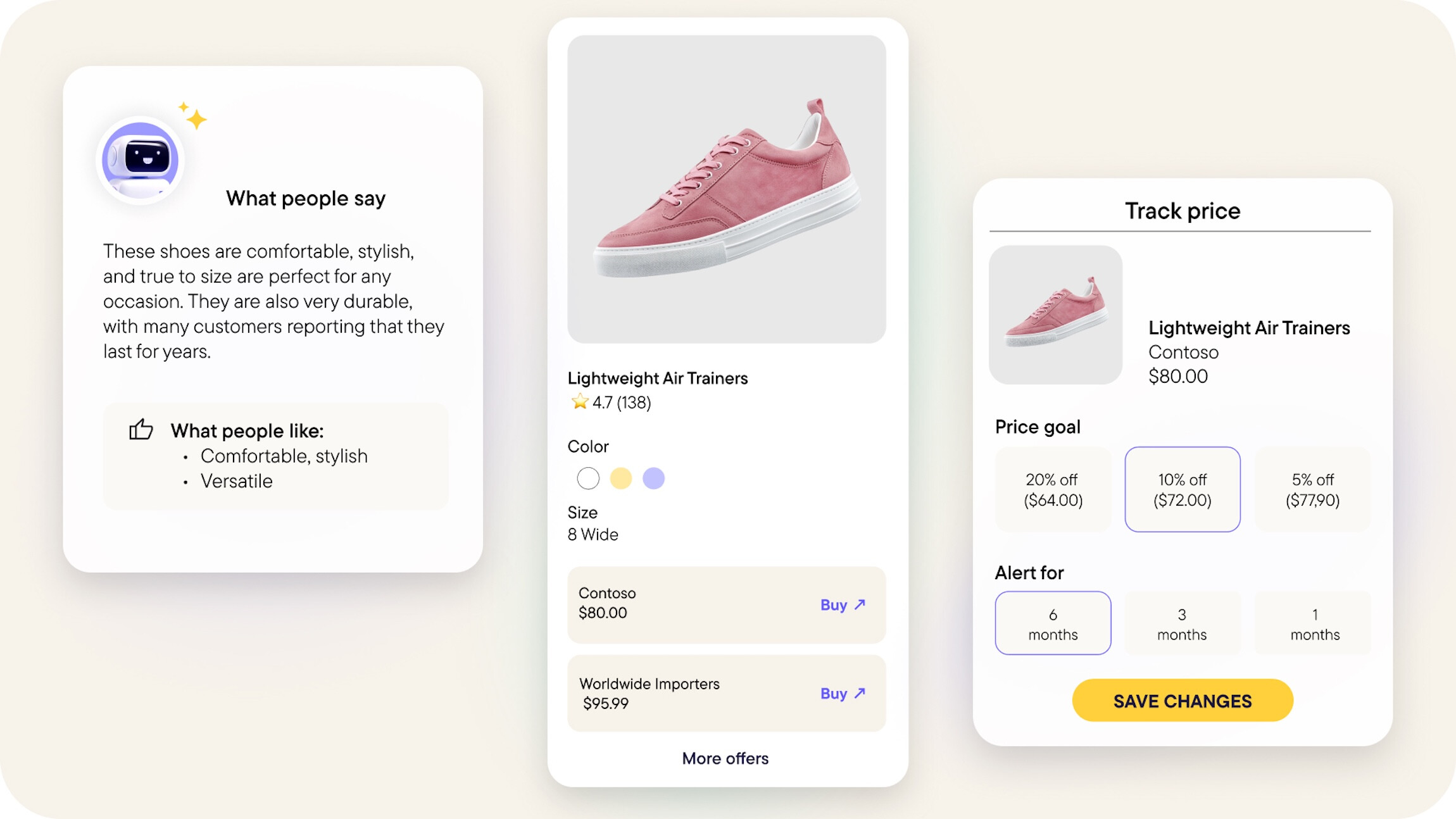
What you’ll learn:

Artificial intelligence is no longer a “nice to have”; it’s fast becoming the engine behind the next wave of commerce transformation. But not all AI strategies are created equal. At commercetools, we’ve made a conscious decision to build a platform that’s AI-native, plug and play, and ready for any business that wants to move fast, act intelligently and operate at scale.
Our architecture is designed to help AI agents think and act like people — at machine speed. That means no replatforming, no patchwork integrations and no guesswork. Just a modular, API-first foundation where AI can understand your data, work across departments and create meaningful outcomes from day one.
With this foundation, our customers don’t just experiment with AI. They adopt it, scale it and win with it.
Elevate 2025: We don’t just say it, we show it
At Elevate 2025, commercetools’ global commerce summit, we brought our vision for AI-powered commerce to life with two keynotes that set the tone for where the industry is headed.
In his opening keynote, commercetools CEO Andrew Burton shared a powerful idea: The future of commerce will not be built by companies that merely transact. It will be shaped by brands that create meaningful, intelligent and adaptive experiences. He called on the industry to move away from brittle, pre-defined flows and toward agentic systems — platforms that sense, decide and act with autonomy.
Agentic systems will not only reduce time to market and improve responsiveness but also foster deeper trust with consumers by delivering relevance in real time. According to Andrew, this shift is not just technological. It’s strategic. It’s about building organizations that are ready to thrive in a world shaped by intelligence and autonomy.
Later, commercetools co-founder and Chief Innovation Officer, Dirk Hoerig, took the stage with Shiri Mosenzon Erez, Chief Product Officer, to demonstrate what agentic commerce actually looks like. In a live, unscripted demo, they showed an AI agent going through a complete shopping experience:
Browsing a catalog.
Comparing similar products.
Adding items to a cart.
Applying promotions.
Completing checkout.
Configuring delivery.
All done autonomously, with no human intervention.
This was not a simulation. It was a real agent running on the commercetools platform, powered by our new Commerce MCP and AI Hub capabilities. Dirk followed the demo with a prediction: By 2030, 30% of digital commerce will be driven entirely by intelligent agents. This was a bold and tangible moment that reinforced our message: We don’t just talk about the future of commerce. We build it.
Three real-world use cases that show AI in action
To understand how this all translates to business value, let’s look at three real-world examples of how AI agents are already changing commerce experiences today.
Imagine a consumer visits your website and is immediately greeted by an AI-powered personal assistant. This agent doesn’t wait for filters to be clicked or search terms to be entered. It already understands the shopper’s preferences, style, price sensitivity and past behaviour and begins guiding them toward relevant products.

As the customer continues browsing, the agent dynamically updates recommendations, compares similar items, bundles relevant accessories and even applies time-sensitive promotions or loyalty rewards. When the shopper is ready, the agent adds everything to the cart and initiates checkout. The entire journey is seamless, hyper-personalized and happens in real time, all without a single line of human-written script.
Now shift to the merchandiser’s point of view. Traditionally, bundling products, A/B testing layouts or adapting creative assets takes weeks of cycles of approvals, testing and developer tickets. But with an AI-powered merchandising agent, that work is compressed into minutes.
Let’s say a particular product is gaining traction. The agent detects rising engagement, bundles it with complementary products and updates the homepage layout automatically. It launches micro-tests on different banner images and headlines, tracks which combination is driving the most conversions, and optimizes in real time, not quarterly.

This allows brands to respond to trends, capitalize on demand spikes and improve outcomes, while freeing creative and marketing teams to focus on strategy instead of operations.
For most organizations, launching a flash sale or running a promotion still requires multiple teams: Marketing drafts the campaign, product teams approve pricing and engineers implement everything. But with AI agents and low-code tools, that complexity disappears.
A marketer using commercetools can configure an agent to monitor specific conditions like low inventory combined with high site traffic. Once triggered, the agent automatically launches a targeted flash sale, adjusts the pricing, updates the product page and sends personalized emails to high-intent users.

All this can happen through a low-code interface with no engineering dependency and no backlog — just business users moving at the speed of the market.
Enabling action through AI-native commerce
So, how are we making this happen? Let’s break down the core innovations behind commercetools’ AI vision and how they enable our customers to move faster and smarter.
The Commerce MCP (model context protocol) is the foundational layer that makes commerce operations machine-readable, semantically rich and ready for agentic action. It doesn’t just expose APIs — it models the business context around them, so AI agents and human users can interpret and act on commerce data with clarity and confidence.
By abstracting key commerce elements, such as product catalogs, pricing rules, promotion logic, cart behaviors and order flows into standardized protocols, MCP becomes the connective tissue between data, decisions and execution.
We’ve introduced two powerful extensions of Commerce MCP:
MCP Essentials is a pre-built toolkit that gives AI agents and business users deep awareness of the commercetools API landscape. It helps them understand catalog structure, promotion rules, pricing configurations and more out of the box. This reduces the time it takes to train agents and accelerates integration dramatically.
Developer MCP is designed for technical users and AI-assisted development. It makes all commercetools documentation, API schemas and business context natively accessible in developer tools like VS Code, GitHub Copilot and LangChain. Developers and AI agents can write, test and validate commerce logic directly inside their IDE, shortening cycles and eliminating friction.
With Commerce MCP, commercetools isn’t just composable — it’s agentic by design.
Agentic commerce is more than a buzzword; it’s a practical framework for autonomous systems to handle meaningful commerce tasks. Think of agents that help shoppers discover and buy, assist merchandisers in optimizing layouts and campaigns, support marketers in launching promotions, and empower developers to build logic through natural language.
These agents are built on a foundation of secure execution, audit trails and governance, so autonomy never comes at the cost of trust. Whether you’re running a B2C shopfront or a global B2B network, agentic systems can adapt to your scale and goals.
To tie it all together, we created the AI Hub, a curated, centralized space for discovering, deploying and governing AI agents within commercetools. AI Hub connects to best-in-class AI models, starting with Microsoft Copilot shopping, and provides templates for common agent tasks, workflows for launching agents safely, guardrails to ensure brand compliance and a roadmap for continual AI innovation with minimal disruption.
Whether you’re experimenting with your first agent or scaling across departments, AI Hub makes it simple to do it the right way with the right controls, models and interfaces in place.
AI is not just changing how commerce works; it is changing what customers expect. Instant personalization, autonomous checkout and proactive support are becoming table stakes. Brands that delay will struggle to keep up with rising consumer expectations, mounting operational costs and a growing innovation gap.
commercetools provides a smarter, future-ready advantage, one that enables businesses to become AI-ready without having to replatform, rebuild or rewire their commerce infrastructure. While many platforms require extensive integration work, vendor lock-in or siloed AI features, commercetools has built an architecture where AI agents can plug directly into existing workflows using the Commerce MCP. This means brands can move at the speed of change, with every AI action grounded in real business context, governed APIs and semantic understanding of commerce data.
Unlike legacy vendors who add AI as a surface-level feature, commercetools is designed to make autonomy native. The Commerce MCP acts above the platform API layer that bridges data, decisions and execution, giving brands a head start in deploying AI agents that are safe, context-aware and production-ready. Whether you are a global retailer or a digital-first disruptor, this approach gives you a competitive edge today, not someday.
This is not a future promise. It is a present-day platform, already powering real-world results. And for business leaders ready to lead, not follow, it offers a rare advantage: The ability to reshape growth strategy with intelligence, autonomy and trust at the core.
Be among the first to explore the Commerce MCP, Agentic Commerce and AI Hub. Get in touch to learn more and secure your access.